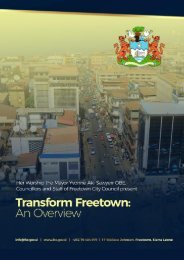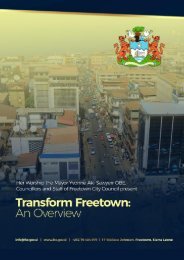FTInsight April/May 2016
Create successful ePaper yourself
Turn your PDF publications into a flip-book with our unique Google optimized e-Paper software.
international migrants will send $601 billion to their families in their<br />
home countries this year, with developing countries receiving $441<br />
billion, says the Migration and Remittances.<br />
Factbook <strong>2016</strong><br />
Currently, no uniform and authoritative historical data on<br />
informal f lows exist. Given the widespread use of informal<br />
remittance channels, the data should be regarded as<br />
underestimates of total f lows.<br />
The United States was the largest remittance source country, with an estimated $56 billion in<br />
outward flows in 2014, followed by Saudi Arabia ($37 billion), and Russia ($33 billion). India<br />
was the largest remittance receiving country, with an estimated $72 billion in 2015, followed<br />
by China ($64 billion), and the Philippines ($30 billion).<br />
The top destination countries<br />
for Sierra Leonean emigrants are<br />
Guinea, the United States, the United<br />
Kingdom, Liberia, Senegal, Germany,<br />
the Netherlands, Australia, Nigeria,<br />
Canada.<br />
The African Institute for Remittances was<br />
launched on 28th November, 2014 to<br />
build the capacity of the Member States<br />
of the African Union, remittance senders<br />
and recipients and other stakeholders<br />
to develop and implement concrete<br />
strategies and operational instruments<br />
to use remittances as development tools<br />
for poverty reduction.<br />
Remittances to sub-Saharan<br />
Africa cost the most. Sub-<br />
Saharan Africa also has the<br />
least eff icient retail payment<br />
systems and regulation that<br />
creates high barriers to entry.<br />
Globally, sending remittances costs an average of 7.37<br />
percent of the amount sent. This figure is used to monitor<br />
the progress of the global effort for reduction of remittance<br />
prices.<br />
South Africa remains the most costly G20 country<br />
to send remittances from, and this is despite a<br />
decline of about 5 percentage points in the last<br />
two years, when the cost of sending from South<br />
Africa was in excess of 20 percent. The cost of<br />
sending from the second most expensive G20<br />
sending country – Japan – was recorded at 11.95<br />
percent, falling below 12 percent for the first<br />
time in the history of RPW. Russia remains the<br />
least expensive G20 sending country, followed by<br />
Saudi Arabia (5.05 percent). Korea (5.54 percent)<br />
and the USA (5.93 percent).<br />
Location, Location, Location! Remittance<br />
costs vary widely between different service<br />
providers. Commercial banks, at 13 percent,<br />
remain the most expensive option for<br />
sending money unless they have dedicated<br />
remittance services. At 7 percent, specialised<br />
money transfer operators are the cheapest<br />
option.<br />
FT<br />
Insight<br />
5<br />
If the cost of sending remittances could be reduced by 5 percentage points, remittance<br />
recipients could receive over $16 billion more each year.<br />
www.ftinsight.net

















